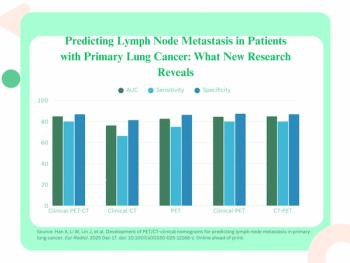
Emerging MRI News and Research — October 2025
Catch up on the most-well viewed MRI content in October 2025.
New magnetic resonance imaging (MRI) research in October ranged from multiple studies on the merits of preoperative breast MRI to emerging findings with ofatumumab for relapsing multiple sclerosis and a new iron-based contrast agent for visualization of malignant neoplasms on brain MRI.
With this in mind, let’s take a closer look at the most well-read MRI content from October.
Is DCE-MRI Sufficient Follow-Up Imaging for Suspicious Calcifications from Mammography Exams?
For suspicious calcifications identified on mammography, dynamic contrast-enhanced MRI (DCE-MRI) may help refine diagnosis and potentially limit unnecessary biopsies.
In a study analyzing 81 women with 86 calcifications,
The study authors maintained that the inclusion of diffusion-weighted imaging (DWI) or quantitative MRI features did not demonstrate clear added diagnostic value beyond standard qualitative DCE-MRI for differentiating these suspicious calcifications.1,2
The utility of DCE-MRI in this setting is further supported by evidence suggesting it could reduce the need for biopsy. For patients with mammographic BI-RADS 4A and 4B calcifications, standard DCE-MRI could have potentially reduced the total number of unnecessary biopsies by 73.0 percent to 77.8 percent in the studied cohort, particularly when calcifications were non-enhancing and high-grade DCIS or invasive cancer was absent.1,2
What Multiple Studies Show About the Impact of Pre-Op Breast MRI
Beyond diagnostic capabilities, new research affirms the impact of preoperative breast MRI on treatment outcomes for breast cancer, particularly in younger women.
Among patients aged 50 or younger who underwent surgery for newly diagnosed breast cancer,
In a separate study,
What Does a New Meta-Analysis Reveal About the PI-RADS v2.1 System for Prostate MRI?
In a
The analysis reinforced the system's high patient-level sensitivity for detecting clinically significant prostate cancer (csPCa), reporting 96 percent sensitivity for PI-RADS category > 3 lesions and 88 percent for PI-RADS category > 4 assessments. Cancer detection rates (CDRs) correlated strongly with PI-RADS categorization, ranging from 3 percent for PI-RADS 1 to 83 percent for PI-RADS 5.7,8
The meta-analysis authors advised caution, however, noting that nearly one-third (29 percent) of the reviewed studies demonstrated a high risk of bias or questionable applicability.7,8
Emerging Developments in MRI Neuroimaging
In contrast agent news, the Food and Drug Administration (FDA) approved Ferabright™ (ferumoxytol injection), making it the
Ferabright offers a long half-life that facilitates flexible MRI protocols and may serve as an alternative contrast agent for patients who are contraindicated for or decline gadolinium, according to Azurity Pharmaceuticals, the manufacturer of Ferabright. The company noted the iron-based agent is processed via natural iron metabolism pathways, minimizing concerns regarding long-term contrast retention.9
In other MRI neuroimaging news, researchers found that
In a recent interview with Diagnostic Imaging, Riley Bove, M.D., noted that study findings of a 98.1 percent reduction in gadolinium-positive (Gd+) T1 lesions at 96 weeks reflected the marked efficacy of B-cell depleting therapies against new focal inflammatory activity in this patient population.10,11
References
1. Park VY, Hippe DS, Kazerouni AS, et al. Multiparametric breast MRI to problem-solve mammographically detected suspicious calcifications. Eur J Radiol. 2025 Oct 11:104:112467. doi: 10.1016/j.ejrad.2025.112467.
2. Hall J. Assessing the utility of mpMRI for enhancing diagnostic clarity with suspicious calcifications from mammography exams. Diagc Imaging. Available at:
3. Yoen H, Skin HC, Yoon KH, et al. Preoperative breast MRI and survival outcomes in women 50 years or younger with breast cancer. Radiology. 2025 Oct;317(1):e250439. doi: 10.1148/radiol.250439.
4. Hall J. New research assesses the impact of pre-op MRI on breast cancer recurrence. Diagn Imaging. Available at:
5. Trinh C, Shi V, Pham T, et al. Preoperative breast MRI for extent of disease evaluation following new breast cancer diagnosis: a retrospective cohort study. J Am Coll Radiol. 2025 Oct 9:S1546-1440(25)00580-0.
6. Hall J. What new research reveals about preoperative breast MRI. Diagn Imaging. Available at:
7. Nedelcu A, Oerther B, Benkendorff A, et al. PI-RADS version 2,1 for prostate MRI interpretation: associations of study quality and cancer detection metrics — a systematic review and meta-analysis. AJR Am J Roentgenol. 2025 Oct 15. doi: 10.2214/AJR.25.33583. Online ahead of print.
8. Hall J. What a new meta-analysis reveals about the PI-RADS v2.1 system for prostate MRI. Diagn Imaging. Available at:
9. Hall J. FDA approves iron-based contrast agent for brain MRI. Diagn Imaging. Available at:
10. Bove R, Langdon D, Boer I, et al. Ofatumumab safety and efficacy in people living with relapsing multiple sclerosis with breakthrough disease on oral fumarates or fingolimod: ARTIOS study. Presented at the 41st Congress of the European Committee for Treatment and Research in Multiple Sclerosis (ECTRIMS), September 24-26, 2025, Barcelona, Spain.
11. Hall J. MRI research shows ‘virtually complete abrogation’ of new lesions with switch to ofatumumab for multiple sclerosis patients. Diagn Imaging. Available at:
(Editor’s note: This article was written with artificial intelligence and reviewed by human editors for accuracy.)
Newsletter
Stay at the forefront of radiology with the Diagnostic Imaging newsletter, delivering the latest news, clinical insights, and imaging advancements for today’s radiologists.




























